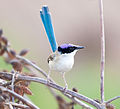| Malurus | |
|---|---|
| Male superb fairywren | |
| Scientific classification | |
| Kingdom: | Animalia |
| Phylum: | Chordata |
| Class: | Aves |
| Order: | Passeriformes |
| Family: | Maluridae |
| Genus: | Malurus Vieillot, 1816 |
| Type species | |
| Motacilla cyanea [1] Ellis, 1782 | |
| Synonyms | |
| |
Malurus is a genus of passerine birds in the Australasian wren family, Maluridae.













